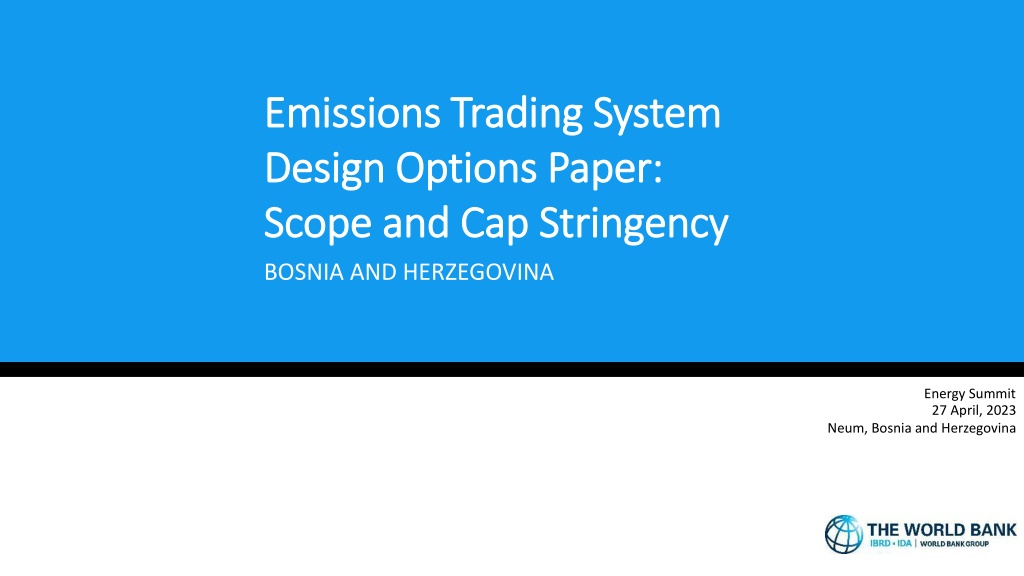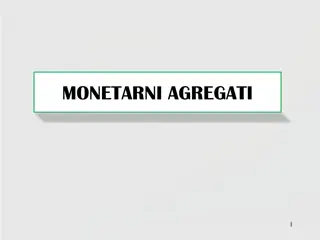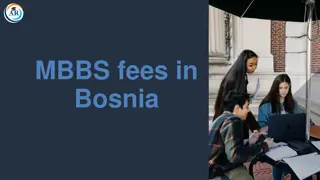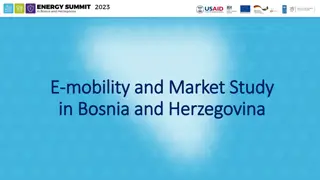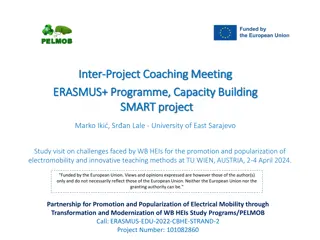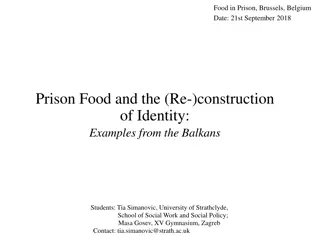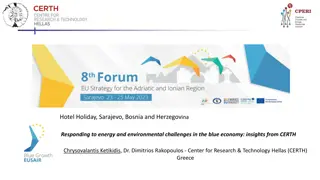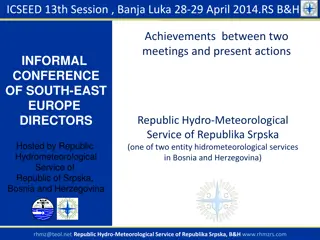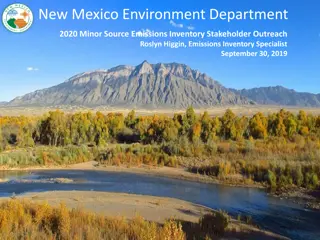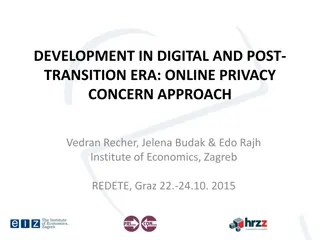Exploring Emissions Trading System Design in Bosnia and Herzegovina
Bosnia and Herzegovina is paving the way for the introduction of an emissions trading system (ETS) through strategic planning and collaboration with international partners. The initiative focuses on key design elements such as scope and cap stringency, aligning with EU climate laws, and engaging stakeholders in the decision-making process. The timeline outlines the steps leading to the delivery of the final ETS design options report.
Download Presentation

Please find below an Image/Link to download the presentation.
The content on the website is provided AS IS for your information and personal use only. It may not be sold, licensed, or shared on other websites without obtaining consent from the author. Download presentation by click this link. If you encounter any issues during the download, it is possible that the publisher has removed the file from their server.
E N D
Presentation Transcript
Emissions Trading System Emissions Trading System Design Options Paper: Design Options Paper: Scope and Cap Stringency Scope and Cap Stringency BOSNIA AND HERZEGOVINA Energy Summit 27 April, 2023 Neum, Bosnia and Herzegovina
BACKGROUND Bosnia and Herzegovina has developed an emissions trading roadmap Starting to consider and plan how the various elements of the EU emission trading system (ETS) and related legislation can be introduced and implemented to enable carbon pricing in a timely manner In the preliminary phase, the focus is on starting a dialogue in the country to explore the main design elements of emissions trading BiH has also passed Monitoring, Reporting and Verification legislation for Greenhouse Gas emissions and reports electricity production emissions and CO2 intensity through the Energy Community. BiH ETS Design Options Report 2
BACKGROUND The World Bank is providing technical assistance, working with the Ministry for Foreign Trade and Economic Relations, as well as other donors, on a one-year project focusing on ETS design options, including computable general equilibrium (macroeconomic) modeling. While there are several other design choices to be made in building an ETS, the decision was made to limit the analysis to scope and cap as they are early and fundamental decisions that need to be taken by the Government Given the close relationship with the EU and political commitments to align with EU Climate Law, these design choices will also be influenced by the design of the EU ETS. Alignment and interactions with the NECP will also be considered. To inform the report and modeling results, workshops with stakeholders will also be held throughout the report writing process. BiH ETS Design Options Report 3
TIMELINE OUTPUT DELIVERY Consultant procurement September October 2022 Contracts signed October 2022 Outline October 2022 Modeling Scenarios* (noting this will be an iterative process) December 2022 (inception report) Workshop 1 Mid-February 2023 Initial modeling results Updating to reflect NECP assumptions Initial modeling results expected later this month First draft of report April 2023 Additional modeling results April / May 2023 Workshop 2 May 2023 Final report + slide deck June 2023 BiH ETS Design Options Report 4
ETS Design Options Paper BiH ETS Design Options Report 5
OUTLINE Section 3: Assessment approach Section 1: Introduction and background Indicators to evaluate design GEM-E3 CGE modelling approach National context: drivers for an ETS, prevailing policies and targets, economic and political context Energy Community context: Regional commitments and work through Energy Community European Union context: implications for accession, ETS harmonization, CBAM implications Section 4: Design options Approach to select design options Outline design options Results of CGE modelling and other indicators Comparison and ranking design options Section 2: Carbon pricing in policy mix Interaction and role of ETS in policy mix, including: Potential need for refocusing fuel subsidies Progress towards a market economy Implications for industrial strategy and just transition Coordination with renewable energy and energy efficiency policy Section 5: Conclusions Recommendations regarding design and chosen option + next steps BiH ETS Design Options Report
EVALUATION INDICATORS Indicator Assessment notes This will be a direct quantitative output of the CGE modelling discussed in later slides Particular attention will be paid to impact on incentivised abatement choices within sectors Macroeconomic impact CGE modelling outputs will provide quantitative assessment of impact on traded sectors Impact on competitiveness Quantitative assessment of impact on bills and disposable income at different income levels Impact by sector will also be discussed qualitatively with respect to potential distributional concerns (eg regionally or on marginalised groups) Distributional impacts ETS can complement, overlap and/or conflict with other policies within targeted sectors Particular attention to be paid to any rationalization with fossil fuel price support Renewable energy capacity expansion plans and policy tools may also interact with ETS impact Interaction with existing policies The complex political structure of BiH needs consideration with respect to administration, verification and enforcement processes and powers Potential political barriers and institutional feasibility The scope of legislative drafting and amendments may differ by sector (a phased approach for implementation will be considered in light of this and other potential benefits) Legal feasibility BiH ETS Design Options Report
MODELING SCENARIOS The team, with input from the government, is developing a series of scenarios to model different options for ETS scope (e.g. which sectors will be covered) and cap ambition The large-scale hybrid CGE model (GEM-E3-BIH) is a tailored version of the model used by European Commission, BiH and other WB6 countries. The following aspects are varied: ETS sector coverage, level of cap ambition, allocation scheme, carbon revenue use Results can help assess how different ETS designs help BiH achieve not only NDC but NECP scenarios and targets (for RE and EE by 2030 and beyond). Equally, how can NECP policies make the ETS more effective and reduce its impact on the economy. BiH ETS Design Options Report 8
MODELING SCENARIOS Sample scenarios include: Initially lower ETS prices (as a % of EU allowance price forecast) vs. delayed alignment with EU allowance prices vs. Immediate harmonization with ETS price forecast Scope: Power sector initially then expanding to industry (as currently in the EU ETS) vs. immediate EU ETS coverage Revenue use: A mix of lump sum to households, R&D investments, labor force training etc. Regional carbon pricing: BiH only vs. Energy Community members adopting a carbon price BiH ETS Design Options Report 9
Other work The World Bank is supporting other carbon pricing work ongoing in the region, including: Montenegro (improving current ETS and looking at options to expand the carbon price signal through crediting or expanding to other sectors), T rkiye (developing a pilot ETS for implementation) and Ukraine (core design elements for a national ETS) are advancing emissions trading work through the World Bank s Partnership for Market Implementation Serbia: modeling carbon pricing and CBAM impacts as part of a broader report on green and resilient growth Upcoming: Regular Economic Report and Country Climate Development Report for Western Balkans will look at CBAM and carbon pricing BiH ETS Design Options Report 10
Thank You BiH ETS Design Options Report 11
